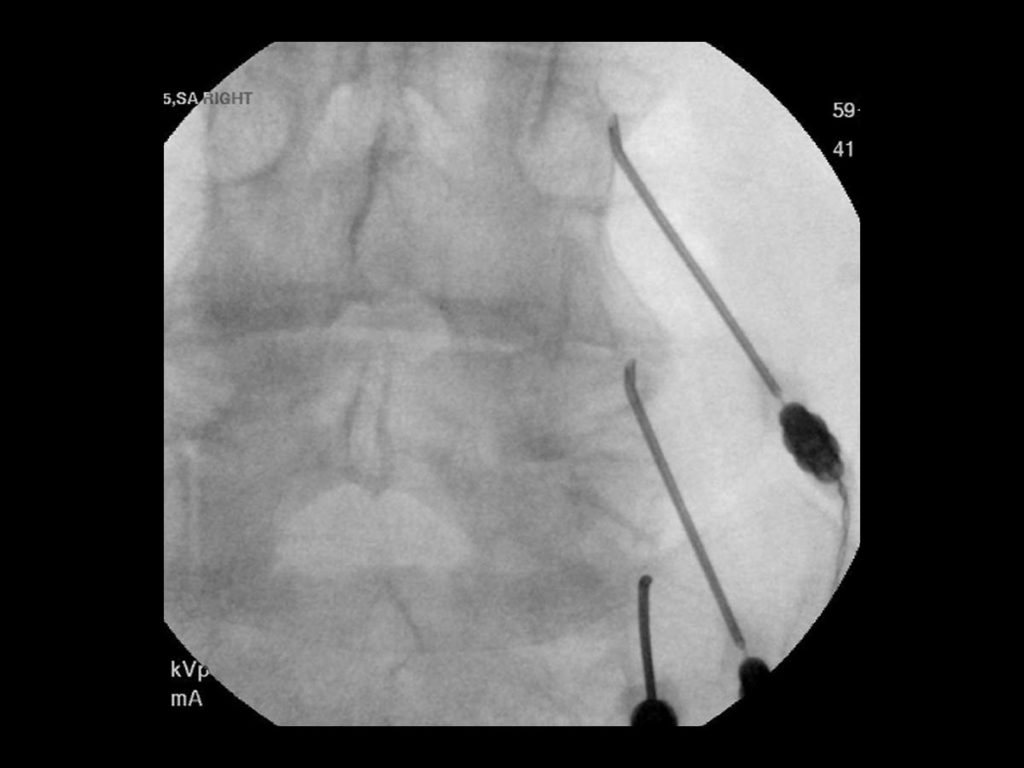Radiofrequency Ablation
Cervical Radiofrequency Ablation
Cervical radiofrequency ablation is used for treatment of neck pain and posterior headaches (cervicogenic headaches). This pain is caused by degeneration and arthritis of the facet joints (joints in your neck).
Cervical radiofrequency ablation uses heat to create a lesion (damaged area) on the outer portion of the medial branch nerve. The lesion impairs the nerve’s ability to transmit signals about facet joint pain. Because the nerve is “turned off,” pain is less intense.
Using fluoroscopy (X-ray imaging) needles are carefully inserted to lie next to the affected medial branch nerve. A small electrode (radiofrequency electrode) is inserted through the needle. To ensure the cannula is in the correct position, a very mild electrical current is delivered through the electrode to the nerve to ensure that the correct nerve is targeted. Numbing medication is provided and the radiofrequency ablation is performed. For most people this sensation feels like a warm cup of coffee.
Results following radiofrequency can take up to 2 weeks to notice. Average benefit lasts 6-12 months. Over time, the nerves will grow back (regenerate) at which point the procedure can be repeated.

Thoracic Radiofrequency Ablation
Thoracic radiofrequency ablation is used for treatment of med back pain. This pain is caused by degeneration and arthritis of the facet joints (joints in you back).
Thoracic radiofrequency ablation uses heat to create a lesion (damaged area) on the outer portion of the medial branch nerve. The lesion impairs the nerve’s ability to transmit signals about facet joint pain. Because the nerve is “turned off,” pain is less intense.
Using fluoroscopy (X-ray imaging) needles are carefully inserted to lie next to the affected medial branch nerve. A small electrode (radiofrequency electrode) is inserted through the needle. To ensure the cannula is in the correct position, a very mild electrical current is delivered through the electrode to the nerve to ensure that the correct nerve is targeted. Numbing medication is provided and the radiofrequency ablation is performed. For most people, this sensation feels like a warm cup of coffee.
Results following radiofrequency can take up to 2 weeks to notice. Average benefit lasts 6-12 months. Over time, the nerves will grow back (regenerate) at which point the procedure can be repeated.
Lumbar Radiofrequency Ablation
Lumbar radiofrequency ablation is used for treatment of low back pain. This pain is caused by degeneration and arthritis of the facet joints (joints in your back).
Lumbar radiofrequency ablation uses heat to create a lesion (damaged area) on the outer portion of the medial branch nerve. The lesion impairs the nerve’s ability to transmit signals about facet joint pain. Because the nerve is “turned off,” pain is less intense.
Using fluoroscopy (X-ray imaging) needles are carefully inserted to lie next to the affected medial branch nerve. A small electrode (radiofrequency electrode) is inserted through the needle. To ensure the cannula is in the correct position, a very mild electrical current is delivered through the electrode to the nerve to ensure that the correct nerve is targeted. Numbing medication is provided and the radiofrequency ablation is performed. For most people this sensation feels like a warm cup of coffee.
Results following radiofrequency can take up to 2 weeks to notice. Average benefit lasts 6-12 months. Over time, the nerves will grow back (regenerate) at which point the procedure can be repeated.

PTCA Treatments
Click on the Treatment below for more information.
